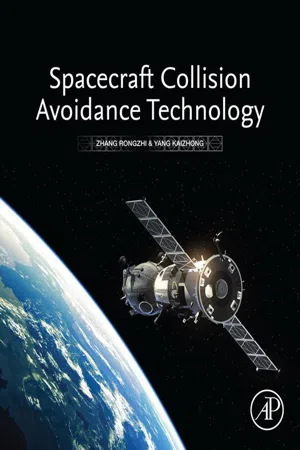
This is a test
- 208 pages
- English
- ePUB (mobile friendly)
- Available on iOS & Android
eBook - ePub
Spacecraft Collision Avoidance Technology
Book details
Book preview
Table of contents
Citations
About This Book
Spacecraft Collision Avoidance Technology presents the theory and practice of space collision avoidance. The title gives models of time and space environment, their impact on high-precision orbit prediction, considers optimal orbit determination methods and models in different warning stages, and establishes basic models for warning and avoidance. Chapters present an outline of spacecraft collision warning strategy, elaborate on the basics of orbital calculation for collision avoidance, consider space object detection technology, detail space environment and object orbit, give a method for spacecraft collision warning orbit calculation, and finally, demonstrate a strategy for spacecraft collision warning and avoidance.
- Presents strategies, methods and real-world examples relating to space collision avoidance
- Considers time and space environment models in orbit prediction
- Gives optimal orbit determination methods and models for various warning stages
- Establishes and elaborates basic models for warning and avoidance
- Takes note of the current space environment for object detection and collision avoidance
Frequently asked questions
At the moment all of our mobile-responsive ePub books are available to download via the app. Most of our PDFs are also available to download and we're working on making the final remaining ones downloadable now. Learn more here.
Both plans give you full access to the library and all of Perlego’s features. The only differences are the price and subscription period: With the annual plan you’ll save around 30% compared to 12 months on the monthly plan.
We are an online textbook subscription service, where you can get access to an entire online library for less than the price of a single book per month. With over 1 million books across 1000+ topics, we’ve got you covered! Learn more here.
Look out for the read-aloud symbol on your next book to see if you can listen to it. The read-aloud tool reads text aloud for you, highlighting the text as it is being read. You can pause it, speed it up and slow it down. Learn more here.
Yes, you can access Spacecraft Collision Avoidance Technology by Zhang Rongzhi,Yang Kaizhong in PDF and/or ePUB format, as well as other popular books in Technology & Engineering & Aeronautic & Astronautic Engineering. We have over one million books available in our catalogue for you to explore.
Information
1
Outline of spacecraft collision warning
Abstract
Since the launch of the first satellite in 1957, the total number of space object has reached the order of 10 millions, and the gross mass is up to 10,000 tons, according to statistical analysis. Up to February 24, 2016, the number of space objects whose diameter is about subsquare-decimeter and can be tracked on the ground is 17,552 in total (from NASA public two-line element data, excluding classified satellites of the United States and its allies). All the space objects, whose diameters are less than subsquare-decimeter fall into the category of space debris. Of the objects larger than subsquare-decimeter, the number of active spacecraft with intact shape is less than 2000, and other 15,000 objects are also space debris, or space junk. It can be seen that space debris constitutes the majority of space objects and the number is still growing. Fig. 1–1 shows the progressive increment of space objects tracked from the ground since 1957 to the present. As depicted in the figure, the number of space objects, especially that of space debris, is increasing at an astonishing speed, in particular, after critical space collisions such as the collision of the US satellite and the Russian satellite on February 11, 2009.
Keywords
Space objects; space debris; trackable space objects; collision prediction; intensive observations; spacecraft collision
1.1 Distribution and characteristics of space objects
Since the launch of the first satellite in 1957, the total number of space object has reached the order of 10 millions, and the gross mass is up to 10,000 tons, according to statistical analysis. Up to February 24, 2016, the number of space objects whose diameter is about subsquare-decimeter and can be tracked on the ground is 17,552 in total [from NASA public two-line element (TLE) data, excluding classified satellites of the United States and its allies]. All the space objects, whose diameters are less than subsquare-decimeter fall into the category of space debris. Of the objects larger than subsquare-decimeter, the number of active spacecraft with intact shape is less than 2000, and other 15,000 objects are also space debris, or space junk. It can be seen that space debris constitutes the majority of space objects and the number is still growing. Fig. 1–1 shows the progressive increment of space objects tracked from the ground since 1957 to the present. As depicted in the figure, the number of space objects, especially that of space debris, is increasing at an astonishing speed, in particular, after critical space collisions such as the collision of the US satellite and the Russian satellite on February 11, 2009.

Although active spacecraft are not the major component of space objects, they play an increasingly important role in today’s information society and are deployed into various orbits according to different applications. Fig. 1–2 shows the distribution of spacecraft in space around the Earth. From Fig. 1–2 the space over the altitude of 36,000 and below 2000 km above the equator is the main ...
Table of contents
- Cover image
- Title page
- Table of Contents
- Copyright
- 1. Outline of spacecraft collision warning
- 2. Basics of orbital calculation for spacecraft collision avoidance
- 3. Space object detection technology
- 4. Space environment and object orbit
- 5. Spacecraft collision warning orbit calculation method
- 6. Spacecraft collision warning and avoidance strategy
- References
- Index